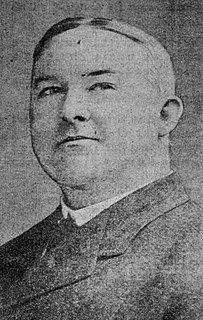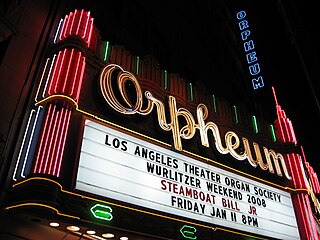Related Research Articles

Vaudeville is a theatrical genre of variety entertainment born in France at the end of the 19th century. A vaudeville was originally a comedy without psychological or moral intentions, based on a comical situation: a dramatic composition or light poetry, interspersed with songs or ballets. It became popular in the United States and Canada from the early 1880s until the early 1930s, but the idea of vaudeville's theatre changed radically from its French antecedent.

Pioneer Square is a neighborhood in the southwest corner of Downtown Seattle, Washington, US. It was once the heart of the city: Seattle's founders settled there in 1852, following a brief six-month settlement at Alki Point on the far side of Elliott Bay. The early structures in the neighborhood were mostly wooden, and nearly all burned in the Great Seattle Fire of 1889. By the end of 1890, dozens of brick and stone buildings had been erected in their stead; to this day, the architectural character of the neighborhood derives from these late 19th century buildings, mostly examples of Richardsonian Romanesque.

Hearst Castle, known formally as La Cuesta Encantada, is a historic, palatial estate in San Simeon, California, located on the Central Coast of California. Conceived by William Randolph Hearst, the publishing tycoon, and his architect Julia Morgan, the castle was built between 1919-47. Today, Hearst Castle is a museum open to the public as a California State Park and registered as a National Historic Landmark and California Historical Landmark.

The Iroquois Theatre fire occurred on December 30, 1903, at the Iroquois Theatre in Chicago, Illinois, United States. It was the deadliest theater fire and the deadliest single-building fire in U.S. history, resulting in at least 602 deaths.

An auditorium is a room built to enable an audience to hear and watch performances. For movie theatres, the number of auditoria is expressed as the number of screens. Auditoria can be found in entertainment venues, community halls, and theaters, and may be used for rehearsal, presentation, performing arts productions, or as a learning space.

Seattle is a significant center for the painting, sculpture, textile and studio glass, alternative, urban art, lowbrow and performing arts. The century-old Seattle Symphony Orchestra is among the world's most recorded orchestras. The Seattle Opera and Pacific Northwest Ballet, are comparably distinguished. On at least two occasions, Seattle's local popular music scene has burst into the national and even international consciousness, first with a major contribution to garage rock in the mid-1960s, and later as the home of grunge rock in the early 1990s. The city has about twenty live theater venues, and Pioneer Square is one of the country's most prominent art gallery districts.

A movie palace is any of the large, elaborately decorated movie theaters built between the 1910s and the 1940s. The late 1920s saw the peak of the movie palace, with hundreds opened every year between 1925 and 1930. With the advent of television, movie attendance dropped and many movie palaces were razed or converted into multiple screen venues or performing arts centers.

A theater, theatre or playhouse, is a structure where theatrical works or plays are performed, or other performances such as musical concerts may be produced. A theatre used for opera performances is called an opera house. While a theater is not required for performance, a theater serves to define the performance and audience spaces. The facility is traditionally organized to provide support areas for performers, the technical crew and the audience members.

Alexander Pantages was a Greek American vaudeville impresario and early motion picture producer. He created a large and powerful circuit of theatres across the western United States and Canada.

The Paramount Theatre is a 2,807-seat performing arts venue located at 9th Avenue and Pine Street in Seattle, Washington, United States. The theater originally opened on March 1, 1928 as the Seattle Theatre, with 3,000 seats. It was placed on the National Register of Historic Places on October 9, 1974, and has also been designated a City of Seattle landmark.

The Bijou Theatre is a theater located in Knoxville, Tennessee, United States. Built in 1909 as an addition to the Lamar House Hotel, the theater has at various times served as performance venue for traditional theatre, vaudeville, a second-run moviehouse, a commencement stage for the city's African-American high school, and a pornographic movie theater. The Lamar House Hotel, in which the theater was constructed, was originally built in 1817, and modified in the 1850s. The building and theater were added to the National Register of Historic Places in 1975.

The Copernicus Center is a 1,890-seat former movie palace that is now part of the Copernicus Center in the Jefferson Park community area of Chicago in Cook County, Illinois, United States. The Copernicus Center is located at 5216 W. Lawrence Avenue.

The Grand Opera House in Seattle, Washington, US, designed by Seattle architect Edwin W. Houghton, a leading designer of Pacific Northwest theaters, was once the city's leading theater. Today, only its exterior survives as the shell of a parking garage. Considered by the city's Department of Neighborhoods to be an example of Richardsonian Romanesque, the building stands just outside the northern boundary of the Pioneer Square neighborhood.

John W. Considine was an American impresario, a pioneer of vaudeville.

John Cort was an American impresario; his Cort Circuit was one of the first national theater circuits. Along with John Considine and Alexander Pantages, Cort was one of the Seattle-based entrepreneurs who parlayed their success in the years following the Klondike Gold Rush into an impact on America's national theater scene. While Considine and Pantages focused mainly on vaudeville, Cort focused on legitimate theater. At one time, he owned more legitimate theaters than anyone else in the United States, and he eventually became part of the New York theatrical establishment. As of 2016, his Cort Theatre remains a fixture of Broadway.

The Ruby Theater is a small movie theater located in Chelan, Washington. Built in 1914, it was named after Ruby Potter, the step-daughter of its manager, Frank Potter. The original owners were Herbert R. Kingman and Morrison M. Kingman. Original seating capacity was 225 on the main level and 125 in the balcony. The theater was equipped as a cinema and as a vaudeville house. With the exception of 1972-1974, the Ruby has been showing movies for over ninety years, and is one of the oldest movie theaters in Washington.

The Nifty Theatre in Waterville, Washington is a small movie theater. The 1919 frame building features Mission Style detailing, and seats just under 300. The theater ceased operations in 1959 and had been used as a storage building until 1997, when new owners restored the theater for community use.
John Hamrick (1875–1956) was an American entrepreneur in the theater business. He leased and owned a large number of vaudeville and movie theaters in the Northwest from at least the early 1920s until the late 1940s. Hamrick lived in Seattle, Washington and eventually assembled a string of theaters that included the Rex Theatre, the Oriental Theatre in Portland, Oregon, the Beverly, several Blue Mouse Theatres, the Music Box Theatre, the Riviera Theatre, and the Roxy Theatre. Hamrick also owned several theaters in Seattle and is generally credited as being the first Seattle theater owner to show "talking pictures."

The Orpheum Circuit was a chain of vaudeville and movie theaters. It was founded in 1886, and operated through 1927 when it was merged into the Keith-Albee-Orpheum corporation, ultimately becoming part of the Radio-Keith-Orpheum (RKO) corporation.

The Orpheum Theatre, originally opened in August 1916, stands on Kellogg Street in downtown Galesburg, Illinois. The Orpheum's elegance and long history made the theatre a landmark in Galesburg which boasts other landmarks such as Carl Sandburg's Birthplace, the Galesburg Railroad Museum, and Knox College, which hosted an Abraham Lincoln-Stephen Douglas debate.
References
- Murray Morgan, Skid Road, Ballantine Books (1960).